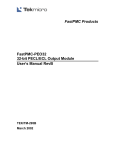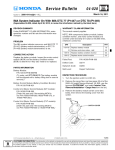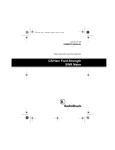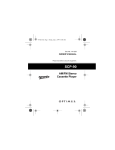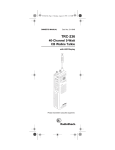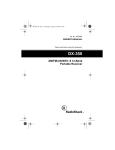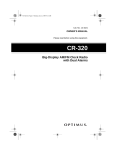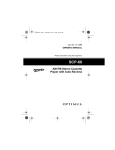Download Radio Shack 21-534 Owner`s manual
Transcript
21-534.fm Page 1 Thursday, August 5, 1999 3:53 PM Cat. No. 21-534 OWNER’S MANUAL Please read before using this equipment. CB/High-Frequency Ham Power SWR Meter 21-534.fm Page 2 Thursday, August 5, 1999 3:53 PM INTRODUCTION Your RadioShack CB/High-Frequency Ham Power SWR Meter helps you tune your CB or amateur radio system for the best performance. CB and amateur radio systems work best when the antenna system’s impedance closely matches the transmitter’s output impedance. The meter’s standing wave ratio (SWR) function helps you trim your antenna to the precise length that produces the maximum transmit power. The meter’s power meter function measures your radio’s peak envelope power (PEP) or average power. Carefully read all of these instructions to get the best use from this meter. Warning: You can use this meter to make measurements on equipment that uses high voltages. Carefully observe all safety precautions provided with the equipment you are testing. Note: You need a separate 50-ohm coaxial cable (such as RG-58U) with a PL-259 connector connected to both ends (such as Cat. No. 278-968, not supplied), long enough to reach from your radio’s antenna jack to the back of the meter. © 1998 Tandy Corporation. All Rights Reserved. RadioShack is a registered trademark used by Tandy Corporation. 2 21-534.fm Page 3 Thursday, August 5, 1999 3:53 PM CONTENTS Measuring SWR . . . . . . . . . . . . . . . . . . . . . . . . . . . . . . . . . Connecting the Meter . . . . . . . . . . . . . . . . . . . . . . . . . . Calibrating the Meter/Measuring SWR . . . . . . . . . . . . . Interpreting SWR Readings . . . . . . . . . . . . . . . . . . . . . Improving SWR . . . . . . . . . . . . . . . . . . . . . . . . . . . . . . 4 4 5 8 9 Measuring Power . . . . . . . . . . . . . . . . . . . . . . . . . . . . . . . 11 Care and Maintenance . . . . . . . . . . . . . . . . . . . . . . . . . . 14 Schematic Diagram . . . . . . . . . . . . . . . . . . . . . . . . . . . . . 16 Specifications . . . . . . . . . . . . . . . . . . . . . . . . . . . . . . . . . 17 3 21-534.fm Page 4 Thursday, August 5, 1999 3:53 PM MEASURING SWR Measuring SWR shows you how much of your radio’s transmit power is reflected from the antenna back into the antenna cable, generating heat and wasting power. With this information, you can adjust the length of your antenna or antenna cable so your antenna and radio combination can produce the maximum power they are capable of producing. For more information about measuring SWR, see the ARRL Handbook, available at your local library. CONNECTING THE METER To connect this meter to your CB or amateur radio and your antenna, you need RG-58U coaxial cable (not supplied) with a PL-259 connector on both ends (such as RadioShack Cat. No. 278-968). The cable must reach from the back of the meter to your radio’s antenna jack. Follow these steps to connect the meter to your radio and antenna. 4 21-534.fm Page 5 Thursday, August 5, 1999 3:53 PM 1. Turn off your radio. Then disconnect the antenna from the radio and plug it into ANTENNA on the back of the meter. 2. Plug the coaxial cable into the radio’s antenna jack and into TRANSMITTER on the back of the meter. CALIBRATING THE METER/ MEASURING SWR 1. Turn on your radio. Then set FUNCTION on the front of the meter to CAL. 2. Select a channel or frequency on your transmitter and hold down its transmit key. Do not speak into the microphone. 5 21-534.fm Page 6 Thursday, August 5, 1999 3:53 PM Notes: • An SWR reading will be different for different frequencies (channels). If you transmit on one channel more often than any other, select that channel. If you transmit on several channels, choose a frequency in the middle of the range of channels you use. (For example, if you transmit on all 40 CB channels, choose Channel 20, because it is midway between Channel 1 and Channel 40.) • If you use a CB that has sideband modes (SSB), do not select any of these modes. (Use only AM for SWR measurements.) • If you have an amateur radio, select the continuous wave (CW) or tuning mode to check the SWR. 3. While you hold down the transmit key, rotate CALIBRATION on the front of the meter until the needle points to CAL. 6 21-534.fm Page 7 Thursday, August 5, 1999 3:53 PM 4. Release the transmit key, then set FUNCTION to SWR. 5. Press the transmit key again, then find the SWR by reading the appropriate scale on the meter. • If your transmitter’s power is less than 20 watts, read the lower scale (marked with an L on its right side) • If your transmitter’s power is more than 20 watts, read the upper scale (marked with an H on its right side) 7 21-534.fm Page 8 Thursday, August 5, 1999 3:53 PM INTERPRETING SWR READINGS An ideal SWR reading is 1.0, but this reading is usually possible only under laboratory conditions or with a dummy load. Actual antenna installations have higher readings. The information below will help you interpret the readings you get. SWR 8 Efficiency Interpretation 1.0 to 1.5 Excellent The antenna cable and the antenna length match the transmitter’s output requirements almost perfectly. 1.5 to 2.0 Very good The antenna, the cable, and the transmitter operate very efficiently. 2.0 to 3.0 Acceptable The antenna, the cable, and the transmitter operate with some loss. If possible, adjust your antenna or antenna mounting system to improve. Above 3.0 Inefficient Adjust your antenna or antenna mounting system to improve efficiency. 21-534.fm Page 9 Thursday, August 5, 1999 3:53 PM When you measure SWR, use this chart to determine the percentage of power that is wasted through reflection of the signal back to the radio. SWR 1.0 1.1 1.2 1.5 2.0 2.5 3.0 Ref. Power (%) 0 0.22 0.8 4.0 11.1 18.4 25.0 For example, an SWR reading of 1.5 also means that 4% of your signal power is lost. However, 96% of the radio’s power is more than enough for almost all applications. IMPROVING SWR There are several ways to improve the SWR of your radio/antenna combination. Try these first. • Be sure you are using the type of cable recommended for your equipment. If the manufacturer recommends a 50ohm cable, do not substitute another type that has a different impedance. • Confirm that you mounted your antenna according to the manufacturer’s instructions. The angle and the base arrangement can affect the SWR reading. 9 21-534.fm Page 10 Thursday, August 5, 1999 3:53 PM • Adjust the length of your antenna according to the instructions provided by the manufacturer. A change of as little as 1 /8 inch can make a measurable difference. • See your radio and antenna’s owner’s manuals. 10 21-534.fm Page 11 Thursday, August 5, 1999 3:53 PM MEASURING POWER You can use your meter to show how much power your radio is transmitting. You can use this information with the SWR reading (see “Measuring SWR” on Page 4) to determine the efficiency of your antenna and radio combination, or to make sure that your antenna and radio combination are operating within legal limits. For more information about measuring power, see the ARRL Handbook , available at your local library. Important: To accurately measure power using SSB, you must connect a low-frequency oscillator (not supplied) capable of generating a 1000–1500 Hz tone signal to the transmitter. This procedure should be performed by a qualified technician. Follow these steps to measure your transmitter’s power output. 1. Set FUNCTION to POWER. 2. Set RANGE on the front of the meter to the correct range for your transmitter. 11 21-534.fm Page 12 Thursday, August 5, 1999 3:53 PM • If your transmitter’s power is 20 watts or less, set RANGE to 20W. • If your transmitter’s power is more than 20 watts but 200 watts or less, set RANGE to 200W. • If your transmitter’s power is more than 200 watts, or you do not know the transmitter’s power, set RANGE to 2000W. 3. Set MODE on the front of the meter to the correct setting for your transmitter. • If your transmitter uses SSB or CW, set MODE to PEP to measure peak envelope power. • If your transmitter uses another type of output, set MODE to AVG to measure average power. 12 21-534.fm Page 13 Thursday, August 5, 1999 3:53 PM 4. If your transmitter does not use SSB, select a channel or frequency on your transmitter and hold down its transmit key. Do not speak into the microphone. If your transmitter uses SSB, input a 1000–1500 Hz tone signal from the low-frequency oscillator you connected to the transmitter. Then, select a channel or frequency on your transmitter and hold down its transmit key. Do not speak into the microphone. 5. Read the power level by noting the needle’s position on the correct POWER scale. • If you set RANGE to 20W in Step 2, read the lower scale (marked with an L on its right side) • If you set RANGE to 200W or 2000W in Step 2, read the upper scale (marked with an H on its right side) Note: If the power level is extremely low within the range you selected, set RANGE to a lower setting and repeat Steps 4 and 5. 13 21-534.fm Page 14 Thursday, August 5, 1999 3:53 PM CARE AND MAINTENANCE Your RadioShack CB/High-Frequency Ham Power SWR Meter is an example of superior design and craftsmanship. The following suggestions will help you care for your meter so you can enjoy it for years. Keep the meter dry. If it gets wet, wipe it dry immediately. Liquids can contain minerals that can corrode the electronic circuits. Handle the meter gently and carefully. Dropping it can damage circuit boards and cases and can cause the meter to work improperly. Use and store the meter only in normal temperature environments. Temperature extremes can shorten the life of electronic devices and distort or melt plastic parts. Keep the meter away from dust and dirt, which can cause premature wear of parts. Wipe the meter with a damp cloth occasionally to keep it looking new. Do not use harsh chemicals, cleaning solvents, or strong detergents to clean the meter. 14 21-534.fm Page 15 Thursday, August 5, 1999 3:53 PM Modifying or tampering with your meter’s internal components can cause a malfunction and might invalidate the meter’s warranty. If your meter is not operating as it should, take it to your local RadioShack store for assistance. 15 21-534.fm Page 16 Thursday, August 5, 1999 3:53 PM SCHEMATIC DIAGRAM (illus - show schematic diagram of meter) Notes: 1. All resistance values are indicated in “OHM” 3OHM). (K=10 2. All capacitance values are indicated in “mF” -6 mF). (P=10 3. All diodes ( 16 ) indicated in 1K100-350. 21-534.fm Page 17 Thursday, August 5, 1999 3:53 PM SPECIFICATIONS Measurable RF Power ...................................... 1–2000 Watts SWR: at 25 Ohms load impedance ...................................... 2.0 at 50 Ohms load impedance ...................................... 1.1 at 100 Ohms load impedance .................................... 2.0 Impedance ................................................................ 50 Ohms Frequency Range ................................................... 3–30 MHz Minimum Input Power for Calibration ........................... 1 Watt Power Meter Accuracy (at 50 Ohms load impedance): 5 Watts ............................................................. ± 0.5 Watt 50 Watts ............................................................. ± 5 Watts 500 Watts ........................................................ ± 50 Watts Dimensions (HWD) ...................... 2 17/32 ¥ 6 15/32 ¥ 4 1/16 Inches (64 ¥ 165 ¥ 102 mm) Weight ........................................................................ 10.9 oz (310 g) Specifications are typical; individual units might vary. Specifications are subject to change and improvement without notice. 17 21-534.fm Page 18 Thursday, August 5, 1999 3:53 PM NOTES 18 21-534.fm Page 19 Thursday, August 5, 1999 3:53 PM Limited Ninety-Day Warranty This product is warranted by RadioShack against manufacturing defects in material and workmanship under normal use for ninety (90) days from the date of purchase from RadioShack company-owned stores and authorized RadioShack franchisees and dealers. EXCEPT AS PROVIDED HEREIN, RadioShack MAKES NO EXPRESS WARRANTIES AND ANY IMPLIED WARRANTIES, INCLUDING THOSE OF MERCHANTABILITY AND FITNESS FOR A PARTICULAR PURPOSE, ARE LIMITED IN DURATION TO THE DURATION OF THE WRITTEN LIMITED WARRANTIES CONTAINED HEREIN. EXCEPT AS PROVIDED HEREIN, RadioShack SHALL HAVE NO LIABILITY OR RESPONSIBILITY TO CUSTOMER OR ANY OTHER PERSON OR ENTITY WITH RESPECT TO ANY LIABILITY, LOSS OR DAMAGE CAUSED DIRECTLY OR INDIRECTLY BY USE OR PERFORMANCE OF THE PRODUCT OR ARISING OUT OF ANY BREACH OF THIS WARRANTY, INCLUDING, BUT NOT LIMITED TO, ANY DAMAGES RESULTING FROM INCONVENIENCE, LOSS OF TIME, DATA, PROPERTY, REVENUE, OR PROFIT OR ANY INDIRECT, SPECIAL, INCIDENTAL, OR CONSEQUENTIAL DAMAGES, EVEN IF RadioShack HAS BEEN ADVISED OF THE POSSIBILITY OF SUCH DAMAGES. Some states do not allow the limitations on how long an implied warranty lasts or the exclusion of incidental or consequential damages, so the above limitations or exclusions may not apply to you. In the event of a product defect during the warranty period, take the product and the RadioShack sales receipt as proof of purchase date to any RadioShack store. RadioShack will, at its option, unless otherwise provided by law: (a) correct the defect by product repair without charge for parts and labor; (b) replace the product with one of the same or similar design; or (c) refund the purchase price. All replaced parts and products, and products on which a refund is made, become the property of RadioShack. New or reconditioned parts and products may be used in the performance of warranty service. Repaired or replaced parts and products are warranted for the remainder of the original warranty period. You will be charged for repair or replacement of the product made after the expiration of the warranty period. (continued) 19 21-534.fm Page 20 Thursday, August 5, 1999 3:53 PM (continued) This warranty does not cover: (a) damage or failure caused by or attributable to acts of God, abuse, accident, misuse, improper or abnormal usage, failure to follow instructions, improper installation or maintenance, alteration, lightning or other incidence of excess voltage or current; (b) any repairs other than those provided by a RadioShack Authorized Service Facility; (c) consumables such as fuses or batteries; (d) cosmetic damage; (e) transportation, shipping or insurance costs; or (f) costs of product removal, installation, set-up service adjustment or reinstallation. This warranty gives you specific legal rights, and you may also have other rights which vary from state to state. RadioShack Customer Relations, Dept. W, 100 Throckmorton St., Suite 600, Fort Worth, TX 76102 We Service What We Sell 3/97 RadioShack A Division of Tandy Corporation Fort Worth, Texas 76102 3A8 811081270A Printed in China




















